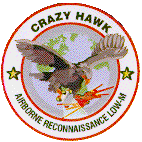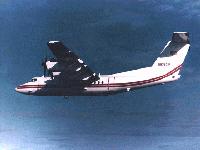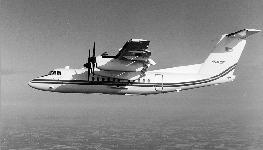




 The Airborne Reconnaissance Low (ARL) is a multifunction, day/night, all weather reconnaissance intelligence asset developed and fielded by the Army in support of an urgent requirement for a low profile intelligence aircraft. ARL is a modified DHC-7 fixed wing aircraft with a core SIGINT and IMINT mission payload controlled and operated via onboard open architecture, multifunction workstations.
The
system developed from a Commander in Chief U.S. Southern
Command (SOUTHCOM) requirement for a manned aviation
platform that could provide an IMINT and SIGINT collection
capability in SOUTHCOM. The design requirements
submitted stated that Airborne Reconnaissance Low should
support nation-building, counternarcotics, and
promote-democracy missions (now classified as stability and
support operations or operations other than war) in
SOUTHCOM's area of responsibility.
The Airborne Reconnaissance Low (ARL) is a multifunction, day/night, all weather reconnaissance intelligence asset developed and fielded by the Army in support of an urgent requirement for a low profile intelligence aircraft. ARL is a modified DHC-7 fixed wing aircraft with a core SIGINT and IMINT mission payload controlled and operated via onboard open architecture, multifunction workstations.
The
system developed from a Commander in Chief U.S. Southern
Command (SOUTHCOM) requirement for a manned aviation
platform that could provide an IMINT and SIGINT collection
capability in SOUTHCOM. The design requirements
submitted stated that Airborne Reconnaissance Low should
support nation-building, counternarcotics, and
promote-democracy missions (now classified as stability and
support operations or operations other than war) in
SOUTHCOM's area of responsibility.

The ARL system has been developed to accommodate diverse mission requirements through the implementation of an open architecture, modular, reconfigurable mission sensors. The SIGINT subsystem has a HF/VHF/UHF intercept and direction finding (DF) capable Electronic Support Measures (ESM) system. The IMINT subsystem is equipped with infrared line scanner (IRLS), forward looking infrared (FLIR), and daylight imaging system (DIS). The core complement of sensors may be augmented with low-light level TV (LLTV), MTI cueing radar, Synthetic Aperture Radar (SAR), multi-spectral camera, acoustic range extension system, precision targeting subsystem, and remote configuration using a direct air-to-satellite datalink.
Two separate systems, the ARL-IMINT (ARL-I) and the ARL-COMINT (ARL-C), designated the O-5A and EO-5B respectively, were initially developed to meet SOUTHCOM's requirements. The ARL-C has a high-frequency, very-high frequency (VHF), and ultrahigh frequency (UHF) direction-finding (DF) capability controlled by four onboard operator stations. Dissemination is through secure UHF (line-of-sight and SATCOM) or VHF-frequency modulation communications, or in the post-mission downloads of COMINT data. ARL-I has three separate imagery systems onboard: first-generation forward-looking infrared camera turret, a day-imaging system camera turret, and an infrared line scanner. The system can send RS-170 video imagery via downlink to commercial off-the-shelf systems, such as TACLINK II, which is a portable video receiver. Two onboard operators can record information on 8-millimeter videotape or transmit "live" to the ground forces commander. The RC-7B, the ARL-M (Multifunction)
includes upgrades to systems already installed on ARL-I and
-C, and added MTI SAR capabilities. Planned SIGINT
collection improvements include the Superhawk radio
intercept and DF system. Four onboard operators manipulate
IMINT, SIGINT, and MTI SAR data. ARL-M has growth
potential to include systems like the Communications
High-Accuracy Location System Exploitation (CHALS-X), a
second-generation FLIR, the Radar Ground Display System,
and improvements to the airframe.
The RC-7B, the ARL-M (Multifunction)
includes upgrades to systems already installed on ARL-I and
-C, and added MTI SAR capabilities. Planned SIGINT
collection improvements include the Superhawk radio
intercept and DF system. Four onboard operators manipulate
IMINT, SIGINT, and MTI SAR data. ARL-M has growth
potential to include systems like the Communications
High-Accuracy Location System Exploitation (CHALS-X), a
second-generation FLIR, the Radar Ground Display System,
and improvements to the airframe.
Three interim capable ARL systems were fielded to the 470th MIBN(LI), Howard AFB, Panama to support SOUTHCOM requirements. These fielded systems are in two different configurations; two for performing signals intelligence (SIGINT) missions (ARL-C) and one for performing imagery intelligence (IMINT) missions (ARL-I). Two ARL-M, multiple mission (IMINT and SIGINT) capable systems, with the addition of an MJI/SAR have been fielded to Korea to perform the I and W mission of the retiring Mohawk (OV-ID). A third ARL-M was completed in FY97. In March 1998 Raytheon Systems Company announced the sale of two additional radar systems for the ARL-M program, bringing to five the total of Raytheon HISAR radars supporting the effort. All interim capable systems will be converted to the multiple mission capable ARL-M configuration.
The ARL-M program represents US domestic sales of the program known internationally as the Highly Integrated Surveillance and Reconnaissance System (HISAR). HISAR leverages military technology pioneered by Raytheon' Sensors and Electronic Systems Segment to provide all-weather, day or night synthetic aperture radar coverage from the same family of radars used on U-2 spy plane and the B-2 Bomber. The system is capable of both air-to-air and air-to-ground standoff imaging with six-meter resolution and a moving target indicator facility, making it a versatile and affordable multi-role surveillance platform. At the core of this multimission system are the SAR and the DB-110 long-range optical sensors derived from the same family of sensors used on the U-2 spy plane, as well as forward looking infrared, signals intelligence sensors, and a variety of radios, datalinks, and ground stations. Another variant of the HISAR package is in flight test for the US Department of Defense Advanced Research Projects Agency's Global Hawk High Altitude Endurance Unmanned Aerial Vehicle.
HISTORICAL BACKGROUND:
May 90 JCS validated Grisly Hunter and ARDF Requirements.
Nov 90 Congress mandated combining of Grisly Hunter and ARDF into a single program called Airborne Reconnaissance Low.
Apr 91 ARL-C and ARL-I Contracts Awarded.
Apr 93 Delivery of first ARL production system.
Jul 93 MSIII Decision for Production of 9 ARL-M.
Sep 93 Multifunction option exercised.
Jun 94 Successful CDR/IPR.
Jun 95 MDS designation RD-7B approved.
Nov 95 MTI/SAR program start.
Jan 96 MTI/SAR CDR.
Sep 96 Delivery fielding of first 2 ARL-M systems.
REQUIREMENTS DOCUMENT: Grisly Hunter Revised SON approved Mar 90. ARDF SON approved Apr 90.
TYPE CLASSIFICATION: LPU approved May 90; TC Standard expected Jun 96.
|
EVENT SCHEDULE FISCAL YEAR |
96 |
97 |
98 |
99 |
00 |
01 |
|
QTR |
1 2 3 4 |
1 2 3 4 |
1 2 3 4 |
1 2 3 4 |
1 2 3 4 |
1 2 3 4 |
|
System 6 FOC |
1-------4 |
|
|
|
|
FEATURES:
|
PHYSICAL PARAMETERS:
PERFORMANCE AND CHARACTERISTICS:
|

